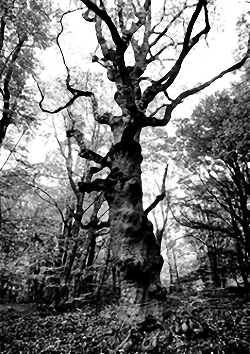1998 – Portraits of Trees
Portraits of Trees
An Exhibition of Photographs by Romeo Di Loreto
In the final chapter of his recent book, Why People Photograph, Robert Adams writes quite wonderfully about what it means to make a landscape photograph:
At our best and most fortunate we make pictures because of what stands in front of the camera, to honor what is greater and more interesting than we are. We never accomplish this perfectly, though in return we are given something perfect – a sense of inclusion. Our subject thus redefines us, and is part of the biography by which we want to be known.
These words provide an apt introduction to the images of Romeo Di Loreto, presented here in a selection that does full justice to the kind of artistic intention Adams so eloquently describes. These portraits of trees clearly are manifestations of the artist’s desire to honor his subjects; equally clearly, they share with the viewer Di Loreto’s affinities for the natural world, and for the forces and spirit of life that are everywhere in evidence in this world.
While the work in this exhibition is recent, it represents a thematic development that has long occupied Romeo Di Loreto. During his undergraduate years, the artist astonished both his teachers and his fellow students with the emotional range and technical mastery of his photographs, and right from the beginning a deep love of nature and the forms through which nature expresses herself was readily visible in his photographs. As time went on, he expanded his work to include three-dimensional elements, found and created objects, references to the spiritual and animistic, and installation pieces. Each new body of work, and each new artistic experience, brought new levels of expression into his imagery, and brought him into contact with a wider range of audiences in both Europe and North America. He now stands as a mature artist and teacher, and a creative individual who is constantly refining and redefining his work. The evidence of this process of refinement is displayed on the walls of this gallery.
Anyone who has seriously attempted to do justice to the landscape through the making of photographs will readily acknowledge what a difficult undertaking it is. It is a measure of Romeo Di Loreto’s success that these images appear so effortless, so spontaneous, so full of meaning, and so alive. That the prints are so warm and translucent is a measure of his skill at the craft of fine printing; that the installation is so effective is a measure of his understanding of the delicate issues of sequence, balance and visual rhythm. Finally, that the exhibition is so rich in expressive value is a measure of why truly good photographs are important to all of us.
As Di Loreto himself writes, “I do not intend to make only representations of reality… I photograph from my emotions with an intuitive response to the land…. At times I reflect what I see, at times I pay homage to what exists or has been lost….” As one journeys through this exhibition, and explores this landscape, one shares experiences with the artist in an uncommonly rich way – a phenomenon all too rare in contemporary image-making. These works are to be experienced, enjoyed, and thought about – and ideally, they should be experienced more than once, since anything of such artistic value grows in meaning with repeated viewing.
November, 1998

